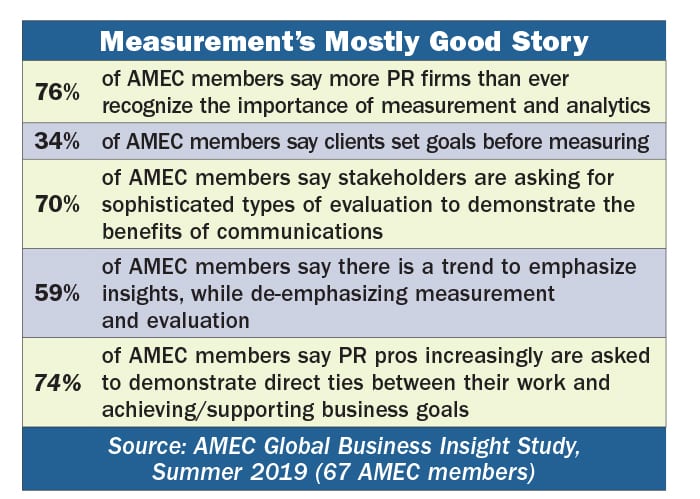
Editor’s Note: As integrated communications campaigns become standard practice, measurement must keep up, with many measurement intelligence firms racing to bolster their offerings. Many firms emphasize providing PR pros with multiple data points on a single platform.

CEO
Burrelles

CEO
TVEyes
At 132 years old, Burrelles is expanding its offering. It’s partnering with TVEyes to offer communicators video, radio and podcast data. The end goal is for Burrelles to offer TVEyes’ media data and intelligence from 150 countries and territories on its single platform, Chaz Waggoner, Burrelles’ CEO, tells us. At present, Burrelles offers TVEyes’ broadcast data from some 20 countries, says David Ives, CEO of TVEyes. Burelles’ platform also is offering TVEyes intelligence from 25,000 podcast sources.
In a wide-ranging interview, we asked Waggoner and Ives about communicators’ measurement challenges, what metrics C-suites are seeking and how AI could change measurement. Their edited responses follow.
PRNEWS: What do you see as the biggest measurement hurdles for communicators?
Chaz Waggoner: Communicators are weighing the cost and effort of measurement against its perceived benefit. A recent AMEC survey found 56 percent of PR pros are unhappy with the availability of measurement information, and 63 percent are dissatisfied with their ability to demonstrate the impact of communications on business outcomes.
PRNEWS: Same question, David.
David Ives: One of the most significant challenges is the difficulty of integrating and measuring different data points across campaigns.
PRNEWS: So communicators want access to multiple data points using a single tool, a single login?
Ives: Yes. For example, broadcast and podcast monitoring within a single dashboard.
PRNEWS: What metrics are C-suites demanding that communicators are having trouble providing?
Waggoner: There’s demand for better tracking of communications programs’ ROI. Fortunately, technology has advanced measurement capabilities in that area significantly.
Executives also want a better picture of how communications and earned media influence the early stages of the marketing funnel: awareness, interest and consideration. Communicators play a big role in promoting and defending brands in these stages. It can be difficult to isolate and measure the impact of communications’ efforts in these areas.
Ives: Increasingly PR is becoming a data-driven profession that depends on comprehensive coverage reports full of in-depth analytics and analysis. Brand leaders want insights from measurement. This means tools need to provide powerful insights about the influence of media coverage on customers and, ultimately, the bottom line.
PRNEWS: As we know, communicators should align metrics with business objectives. What issues are you seeing there? Are communicators informed enough about business to grasp its objectives? Do you find situations where objectives are unclear? What’s the solution?
Ives: For a company to have a successful PR strategy, it is imperative that its business goals are clear and measurable. This means a company must be able to rely on data that helps it measure strategy against goals. For example, have your efforts fueled an increase in profitability, expanded social media followers or changed brand sentiment?
Waggoner: Most communicators are savvy when it comes to their businesses, industries and program objectives.
The issues they may find challenging are how to establish quantitative KPI and benchmarks against communications activities, particularly in social media.
There are a lot of output metrics, like reach and share of discussion, that can help. In addition, you can quantify activity around key message points. These, in turn, can be correlated with progress against business objectives to provide insights into what is really moving the needle.
PRNEWS: What do you see happening in communication measurement and AI in five to 10 years? Will AI eliminate human analysts and make measurement less expensive? What should communicators do now to get ready?
Waggoner: AI is here to stay. It should do a lot to make measurement faster and less expensive. Technologies like facial recognition, logo detection, sentiment analysis, speech-to-text and translation services also make a raft of new measurement services available that just wouldn’t have been feasible even five years ago.
That said, it will be quite some time before AI can provide the insights and accuracy you get from human analysts. Communicators should maintain a healthy skepticism when they evaluate AI-generated measurement results. For now, stick with the programs that produce actionable insights for your business.

PRNEWS: Chaz, what’s ahead in measurement?
Waggoner: Logo detection. Several companies have made strides in it. While it’s still early, the ability to apply this technology at scale is going to enhance the tracking of brand presence across all media types.
PRNEWS: David, are certain metrics emerging as favorites for tracking podcasting?
Ives: Without a doubt. Listener data is the most relevant for podcasters, brands and PR pros. As the podcasting space evolves and matures, other data, such as total subscribers and downloads, will become increasingly important as it has on other mediums such as YouTube. Advertising will be the impetus for more data. As a result, the PR industry will greatly benefit.
